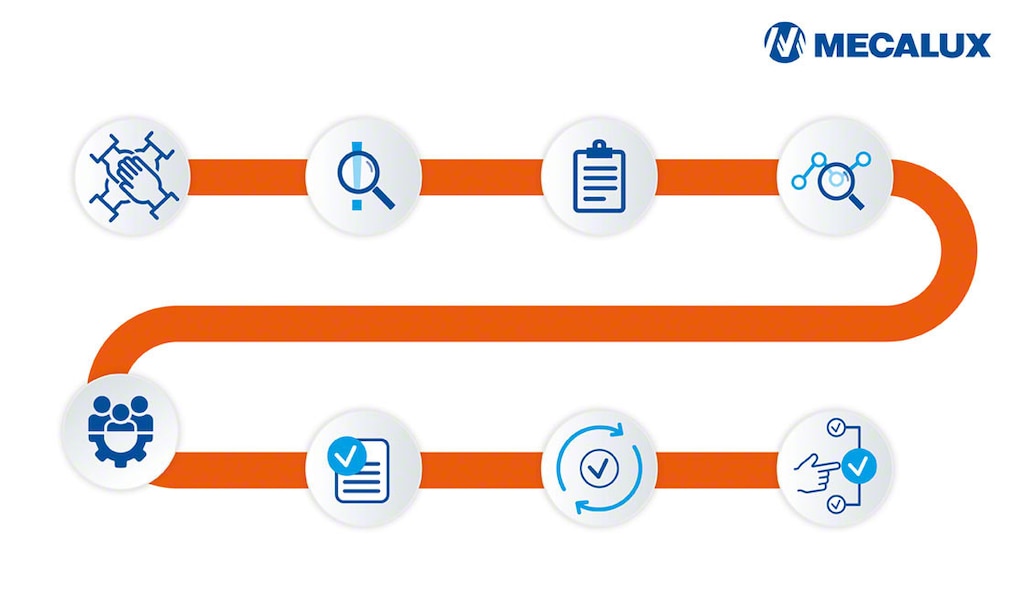
What is 8D? The methodology transforming problem-solving and quality management
8D is a problem-solving methodology that enables managers and team leaders to reach solutions collaboratively. This method is essential for boosting quality and operational efficiency. By working through a series of steps, the process typically results in a formal report. Adopting 8D is crucial for any organization seeking excellence: it not only addresses the root cause of issues but also sets up mechanisms to prevent them from recurring. By applying its eight disciplines, companies can achieve significant improvements in product or service quality while optimizing operational performance.
In this post, we’ll dive deep into what the eight-step methodology entails and its core purpose. We’ll also highlight the benefits it brings to businesses, from reducing defects to increasing customer satisfaction. Finally, we’ll break down the steps required to implement 8D effectively.
What does 8D mean?
8D stands for the eight disciplines of problem-solving. This method is used to identify, correct, and eliminate issues in just a few steps. It’s a quality management tool that supports organizations in tackling complex situations efficiently.
Each of the eight disciplines focuses on a specific part of the analysis needed to pinpoint and eradicate a problem’s root cause. By reducing the likelihood of errors and helping fine-tune products and processes, the 8D method is a valuable ally for businesses committed to operational excellence and continuous improvement.
Origins of the 8D methodology
While its roots may go back further, Ford was the first company to formally introduce the 8D method. This happened in the 1980s, a period of major change in the industry driven by the need to optimize processes and outcomes.
The 8Ds were initially called Team Oriented Problem Solving (TOPS). Based on data analysis for tackling and resolving challenges, this approach led to greater quality control and fewer errors, enhancing user satisfaction. TOPS marked a significant evolution in problem management, enabling teams to identify root causes and implement effective solutions. Its adoption set a benchmark for continuous improvement and operational efficiency across the industry.
Benefits of the 8 disciplines of problem solving
Applying the 8D method to identify and correct inefficiencies offers businesses multiple advantages:
- Greater collaboration. By involving multiple team members in finding solutions, 8D strengthens problem-solving skills and encourages teamwork.
- Deeper understanding. The method allows companies to gather more insights into internal processes and the needs of different departments, broadening organizational knowledge.
- Data-driven approach. 8D relies on data analysis to evaluate the scope, frequency, impact, and patterns associated with a problem.
- Promotion of transparency. Engaging professionals and establishing clear communication channels helps resolve issues more effectively.
- Future-proofing. By addressing weak points in processes, businesses can prevent subsequent conflicts or breakdowns.

8D reports
To implement 8D, organizations use 8D reports. They serve as a formal communication tool that documents each of the eight steps, from identifying the problem to verifying preventive actions and closing the process. Often, an initial phase is added to gather all relevant information about the issue at hand.
Before deciding who will participate in the problem-solving process, it’s useful to collect background information on the incident. Gathering feedback from employees and managers can also help determine what’s needed to resolve the issue effectively.
D1: Team creation
To start applying the 8D methodology, the company should establish a dedicated team composed of professionals familiar with the products and processes involved. For optimal results, team members should volunteer to participate rather than being assigned, ensuring genuine engagement.
D2: Problem definition (in seven questions)
Using the information gathered during the preparation phase, participants will have enough data to define the problem clearly. This involves answering seven key questions:
- Report source. Who raised the issue?
- Problem description. What exactly is the issue?
- Timeline and frequency. When did it first occur, and how often does it happen?
- Location and context. Which department, supplier, machine, or production line is involved?
- Purpose. Why must this problem be solved?
- Initial detection. How or by what method was the problem first identified?
- Organizational impact. How many pieces, units, or customers are affected?
D3: Interim containment actions
Some issues cannot be resolved immediately and require time and effort. To allow for proper development within the 8D framework, this phase involves implementing temporary measures to contain the problem. This step is especially critical if the incident affects customers, as it helps keep them informed and protects the company’s reputation.
D4: Identification of root causes and escape points
This stage involves reviewing the responses from D2 with the team and reflecting on how the problem occurred. All potential causes must be considered and linked to the events.
Once the main reasons are identified, the team also investigates why the problem wasn’t detected earlier. In 8D terminology, this oversight is known as an “escape point.”

D5: Selection of permanent corrective actions (PCAs)
With the different aspects of the problem and its root causes in mind, the next step is to determine the definitive solution. Before closing this stage, it’s important to establish whether the team will require external support to resolve the issue, propose potential corrective actions, and assess any associated risks. It is also advisable to collect evidence related to the measures being applied to ensure their effectiveness.
D6: Implementation of PCAs
At this point in the 8D process, the temporary measures introduced in Step 3 can be removed. Going forward, control mechanisms should be put in place to verify whether the final solution is working or if a more effective approach is needed.
D7: Recurrence prevention
Beyond addressing current issues, the 8D method also aims to prevent them from happening again in similar situations. For example, one preventive measure might be to provide employees with training on a specific topic.
D8: Team recognition
A positive attitude and commitment are vital to the success of the 8D process. For this reason, it’s worth taking time to acknowledge each team member’s work and contribution throughout the project.
8D example: How to apply it
Once you understand how the 8D method works, you can apply it to problem-solving across different sectors and industries. Take the example of a manufacturing company that has been receiving customer complaints because one of its motherboards is experiencing power supply issues.
- A team is formed with members such as the quality manager, engineers, and customer service technicians.
- This team describes the problem, defines its scope, and studies the timing of its occurrence. It’s also important to determine the scale of the issue. Does it affect only one model or other products as well?
- While the incident is being resolved, containment actions are taken: all boards of that model are held in the warehouse, and replacements are provided to customers.
- To identify the root cause, the conditions under which the failure occurs are replicated, defective units are analyzed, and components, as well as the power supply process, are reviewed.
- Permanent solutions are decided, such as switching suppliers for a particular component or redesigning the motherboard.
- Steps are taken to implement these changes, e.g., issuing new purchase orders or rolling out the design modifications.
- The case is documented so that the lessons learned can be integrated into future products.
- The team’s work is acknowledged, and the positive results are shared with management and other stakeholders.
The power of 8D
The 8D methodology has become an indispensable tool for solving problems effectively and systematically in any sector. Adopting it not only enables companies to correct existing failures but also fosters a culture of continuous improvement and organizational learning. By consistently applying the eight disciplines, businesses can streamline processes, enhance the quality of products or services, and strengthen customer satisfaction. Ultimately, the 8Ds are more than just a sequence of steps — they’re a proactive mindset that empowers teams to tackle and overcome challenges.
8D in 5 questions
What is 8D?
8D is a problem-solving methodology widely used in industrial environments. Its application helps identify and resolve issues of all kinds, supporting operational excellence and continuous improvement.
Who created the 8D method?
Ford popularized 8D in the 1980s. This problem-solving system improved quality control, reduced errors, and boosted customer satisfaction through structured data analysis.
What are the main advantages of the 8D method?
Applying 8D encourages teamwork and collaboration, enhances process understanding through statistical data analysis, promotes transparency in problem-solving, and prevents inefficiencies by addressing weak points.
What are the steps of 8D?
The 8D problem-solving method consists of eight steps: establishing the team, defining the problem, developing a temporary solution, identifying root causes, selecting corrective actions, implementing them, preventing recurrence, and recognizing contributors.
Where can the 8D method be applied?
The 8D approach can be implemented across many fields. In logistics, it helps resolve delivery and inventory issues. In quality control, it strengthens service through preventive measures. And in occupational safety and health, it reduces the risk of recurring incidents.
